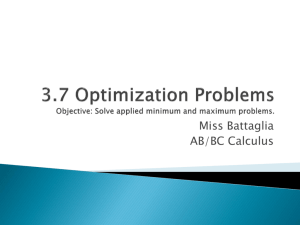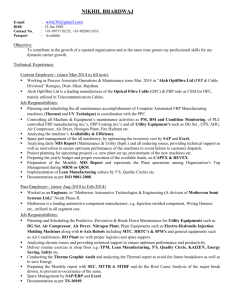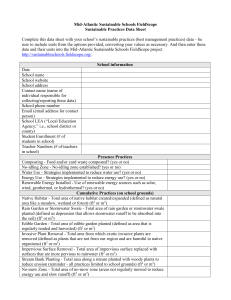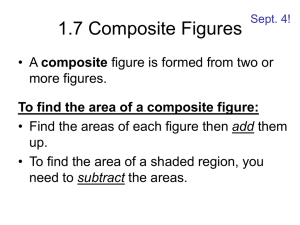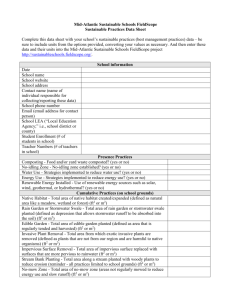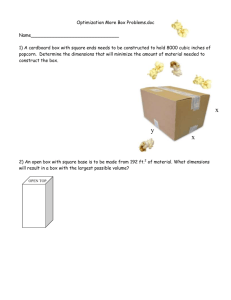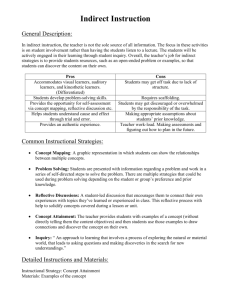on fire
advertisement
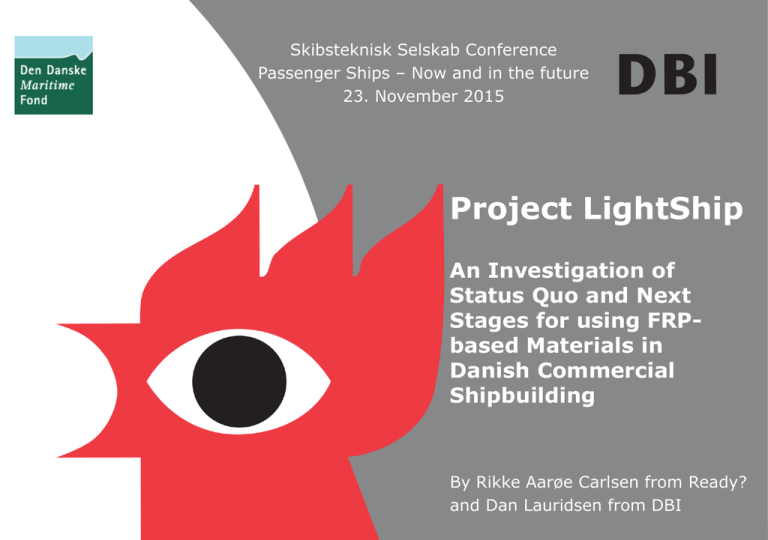
Skibsteknisk Selskab Conference Passenger Ships – Now and in the future 23. November 2015 Project LightShip An Investigation of Status Quo and Next Stages for using FRPbased Materials in Danish Commercial Shipbuilding By Rikke Aarøe Carlsen from Ready? and Dan Lauridsen from DBI Project detail Small non-academic project in regard of FRP usage in commercial shipbuilding (in Denmark and the neighboring countries). 3 months duration. Project team and Advisory Group. Status and Idea Catalogue. • Mapping of: ‒ ‒ ‒ ‒ stakeholders, existing rules and status for coming rules or guidelines, known research capabilities in the topic, significant development projects the last 10-15 years, • Identification and description of barriers, • Listing of relevant ship types with current or likely coming usage of FRP. Ship types and usage Danish flag was focus for the project. Considered ship types and usage: Ship Category Usage FRP application Conv. HSC Cargo (incl. SPS) X X Passenger X X RO-RO Cruise Special personn el X Open Sea Coastal X X X X X X X X X Port areas Hull / protected X Super structure Component / equipment X X X X X X X X X Stakeholders • Authorities, ‒ IMO (International Maritime Organization), ‒ The European Union, ‒ National maritime authorities, in Denmark the DMA. • • • • Classification societies, Shipowners, Shipyards, Technology providers, like ‒ material producers, ‒ component suppliers. • Naval architects/consultants, • Universities, • Test & Development Institutions. Value Chain Timeline Overview some Projects Areas investigated Area investigated: Weight saving Fire safety and test Joints between materials Risk based regulation LCCA (Life Cycle Cost Assessment) LCA (Life Cycle Assessment) New materials Structural design Degradation of composites Inspection of defects and damages Certification of FRP elements Global strength Production process Patch repair Number of projects looking at this area: 6 6 4 3 3 3 2 2 1 1 1 1 1 1 Hazard ranking 1.Fire 2.Toxicity 3.Structural Collapse / Loss of strength 4.Ice sailing •Wrong Emergency Response (operational) Fire Hazard & Risk of Fire • Fire is regarded as the greatest hazard among those interviewed • Along with risks associated with heat and flame • Agreement fire hazard always present • Not sharing opinion on risk • Technical aspect • Regulatory aspect Toxicity Hazard & Risk of Toxic Smoke • Toxicity is regarded as the second highest ranked hazard among those interviewed • Smoke from burning FRP is toxic ‒ However, all smoke is hazardous ‒ Shift focus to on how to avoid exposure to smoke • Increased risk of the burning FRP material producing excessive amounts of smoke, toxic or not. Structural Hazard & Risk of Collapse • Structural Collapse / Loss of strength were regarded as the third highest rank hazard among those interviewed • Whether the cause being a fire or a collision the material’s potential lack of sufficient residual strength poses a risk that stakeholders are generally concerned with • Issues in loosing strength as a consequence of for example elevated temperatures or deflection ‒ But good structural features of FRP in terms of flexibility and strength in all directions. Focus should then be of loss prevention and risk reduction, through other means that are not yet fully investigated. Ice Hazard & Risks associated • Ice sailing is regarded a high ranking hazard among those interviewed • Ice as a hazard only exists if a ship operates in certain cold geographical areas. • Whether it poses a bigger risk to a FRP ship compared to steel or aluminium ships, further depends on the operational mode and design criteria. • Varying opinions on the usability of FRP in ice • Different opinions on whether it is really of interest to focus on. Organizational Hazards & Risks • Wrong Emergency Response and operational hazards in general, are regarded as high ranking hazards • Matters such as crew manning and external readiness • Crew preparedness? • Level of knowledge (or lack of) about FRP on ships both in operation and emergency situations Barriers and challenges Perceived or real ? • • • • • • • • Regulation Parties’ limited risk analysis experience Functional criteria lacking, methods and standards lacking Damage detection and repair Conservatism and 1. mover risk avoidance Tendering rules Shipyards issues on size and FRP engineering FRP technical challenges and uncertainties “Noise” from to many technical experts with individual specific knowledge clouding the message ? Barriers and Interdependency Financial incentive / volume ? Approval? Documentation? Financial incentive? Delays from approval procedure? Ship owners Producers Shipyards Authorities Documentation? Safety vs Risk assumptions? Approval? Capacity? Moving out of Status Quo • Smaller steps for incorporating FRP in the commercial shipbuilding industry – in aiming for step by step approval – is likely to be more successful, than an “all or nothing” approach • Modular approach has some foreseen benefits, like: ‒ focus the research and development on certain elements of the topic ‒ enable authorities to prepare an approval scheme with safety level differentiation ‒ allow technology and regulation to follow each other ‒ incremental steps align with the conservatism while still preparing for slight change Prioritized Initiatives 1. 2. 3. 4. 5. 6. 7. 8. Functional criteria for alternative material Components and equipment in FRP Combatting FRP fire risk: a multi-angles approach Focus on one FRP ship type and operation Operational focus for FRP on ships Adjustments to tendering rules Enhancing knowledge transfer New cooperation approach to FRP • Documenting full scale FRP ship fire Ex.: Combatting FRP Fire Risk: A multi-angles Approach Scope Overall fire focus on FRP material and joints Being able to handle the FRP fire risk, either through eliminating the combustible elements, or actively preventing fire, or a combination of this. Verifying material properties. Brief description Develop applicable non-combustible FRP. Applicable to usage on ship, so must have a full matrix of suitable properties for marine usage. Developing fire-resistant system solutions, for example by limiting the use of combustible materials for specific functions or sections on the ship. Defining a Fire Safety Engineering approach to fire safety making fire safety a design parameter for future use of FRP. Possibly establish a simpler test method to classify a material or construction Fire Restricting Material (FRM), making it a viable alternative the large and expensive full scale room corner test in ISO 9705. Investigate structural features with focus on loss prevention and risk reduction. Foreseen Test & development institutions, material providers, universities, consultants. participants Ultimate goal Creating Momentum • First-mover avoidance can be reduced by the smaller steps, but not entirely avoided ‒ Risk taking and knowledge gaining ‒ Shared possibilities for risk and opportunity • Look at upsides and downsides from an overall business perspective • Recognize there must be a clear customer need to drive the process • Usage of newer technologies, and tailoring the rules and regulations, is seen as crucial for successfully bringing FRP into commercial shipbuilding • Development and technical knowledge from universities as well as industry Knowledge Opportunity Fiber reinforced polymer “on fire” Material-level Fire retardants Principle of fire retardants Endothermic degradation: (effect on heat) Magnesium and aluminum hydroxides, Calcination in gypsum Thermal shielding, solid phase: (effect on heat, oxygen and fuel) Intumescent materials, Nano clay, ordinary char Dilution, gas phase: (effect on oxygen and fuel) Inert gases produced by thermal degradation Gas phase radical quenching: (effect on heat) Release hydrogen chloride or hydrogen bromide FRP composite “on fire” composite - level Temperature De-bonding De-bonding Laminate Laminate Core material Resistance to fire testing Prescriptive requirement for the structural core to be made of steel or equivalent. Thermal exposure Time-temperature curve (ISO 834) A-60 bulkhead Performance Integrity: No flames or holes in 60 minutes Insulation: Max temperature rise 140°C/180°C in 60 minutes Insulation Insulation FRP composite sandwich Statutory matrix for FRP vessels Vessel type Regulation FRP construction Remarks < 24m and < 12 PAX. Meddelse F Danish notation • Pax can sleep onboard • International operation but regulated operation range • One navigator DMA accepts the use of FRP in construction Not guaranteed to be accepted outside Denmark < 24m and > 12 PAX. High speed craft (HSC code) • No PAX sleeping onboard • No crew sleeping onboard • International operation • Fixed routes • Two navigators HSC code allows alternative materials like FRP International accepted Positive towards toward alternative materials like FRP > 24m and > 12 PAX. Ferry Directive (Meddelse D) • Allows designs according to HSC HSC code allows alternative materials like FRP DMA allows design according to undefined “Slow speed craft” based on HSC. No international or regional accept when using the national “Slow speed craft” based on HSC. SOLAS Do no allow widespread use of alternative materials like FRP and if, regulation 17 is to be used. International accepted. Using Regulation 17 is extensive and unprecedented. Regional operation > 24m and > 12 PAX International operation Fire safety according to SOLAS Prescriptive approach Fulfill: Prescriptive requirements in Part A and Part B, C, D, E, G Regulation 17 approach Fulfill: Prescriptive requirements in Part A, F and fire safety objective and functional requirements in Part B, C, D, E, G. “At least as safe as if it would have been designed according to prescriptive requirements” Guidance on “how” in MSC/Circ. 1002 generally known as fire safety engineering (FSE) using the method described in MSC/Circ. 1455. News from IMO on FRP guideline The text in the Swedish proposal has been finalized by SDC and submitted to MSC…….. and rejected. MSC replied: Not good enoughs – you are welcome to submit a better guideline. Norman Atlantic COMPASS - "implicit robustness" COMPASS - in pursuit of "implicit robustness" Purpose: Comparative testing of steel, aluminum of FRP deck and bulkhead. In order to quantify implicit robustness in a reproducible manner, which will enable method for ship builders to verify equivalent implicit robustness for ships build according to different regulation, using different materials (steel, aluminum and FRP). Task specification: Test of a number of full size load bearing structural elements in order to understand issues at hand. Thermal exposure: Natural fire curve. A natural fire curve imposes novelty with in resistance to fire testing as this is not tested in accordance to the FTP code. Structural elements: All bulkheads and deck should be insulated to fulfill the Class A-60 requirement and the structural element should be loaded. New business, build lightweight Wing in ground plane (ship) Doors Toilet Fire protection (fire spread) Sprinklers (external) Pipes and cables Ship Furniture Ventilation Find the Status Report and Idea Catalogue at dbi-net.dk THANK YOU! QUESTIONS?
